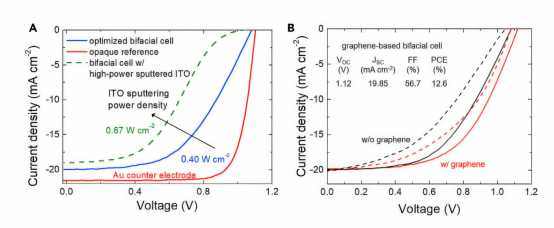
量子效率测试仪
PL/EL一体机
Sinton硅片少子寿命测试仪
Sinton硅块少子寿命测试仪
绒面反射率测试仪
3D共聚焦显微镜
清洗制绒工作站
在线四探针方阻测试仪
全自动扫描四探针方阻测试仪
在线薄膜厚度测试仪
晶化率测试仪
Horiba显微共焦拉曼光谱仪
傅里叶红外光谱仪
霍尔效应测试仪
分光光度计
全光谱椭偏仪
Horiba椭圆偏振光谱仪
TLM接触电阻率测试仪
超景深显微镜
网版智能影像测量仪
全自动影像测量仪
卧式拉力机
电池片稳态光衰老化试验箱
电池片紫外老化试验箱
电池片拉脱力综合测试仪
外观检验台
湿漏电测试系统
组件实验室EL测试仪
紫外老化试验箱
稳态光衰老化试验箱
电流连续性监测系统
PID测试系统
旁路二极管测试系统
LeTID测试系统
反向电流过载系统
脉冲电压测试系统
绝缘耐压测试仪
接地连续性测试仪
绝缘耐压接地测试仪
湿热环境试验箱
湿冻环境试验箱
热循环试验箱
动态机械载荷测试机
静态机械载荷测试机
冰雹冲击试验机
引出端强度试验机
霰弹冲击试验机
抗划伤(切割)测试机
剥离试验机
万能材料试验机(单臂)
万能材料试验机(双臂)
光伏玻璃透过率测试仪
醋酸测试试验箱
交联度测试系统
二极管接线盒综合测试仪
落球冲击试验机
半自动四探针
全自动探针式台阶仪
多通道太阳能MPPT系统
Horiba稳瞬态荧光光谱仪
钙钛矿P1激光划线测试仪
钙钛矿在线膜厚测试仪
钙钛矿工艺检测工作站
手持式IV测试仪
便携式EL测试仪
手持热成像测试仪
户外组件IV测试仪
户外组件多通道测试系统
光伏逆变器电能质量测试仪
无人机EL检测仪
意大利Casaccia 研究中心&罗马理工学院Joule发布:机械堆叠结构的钙钛矿/晶硅叠层太阳能电池效率超26%
日期:2024-10-22浏览量:45
市场领先的晶硅光伏技术成本降低但效率接近理论极限,为提高效率并降低成本,晶硅叠层太阳能电池成为研究热点,机械堆叠结构作为一种简单的和电池制备工艺兼容的方案,是叠层太阳能电池领域的新选择。通过钙钛矿吸收体并达到ITO界面的光的总平均反射率与ITO厚度的关系,利用分光光度计测量光的反射率来确定 ITO 的最佳厚度。美能分光光度计在光伏领域中主要用来测ITO薄膜的反射率和透过率,全设备采用独特的双光束光学设计,测试范围广、精度高、稳定性好。
机械堆叠的钙钛矿/晶硅叠层太阳能电池的结构

机械堆叠的钙钛矿/晶硅叠层太阳能电池的结构
可以直观地看到这种机械堆叠设计的优势。这种设计可以利用金属化和双面纹理的 Si HJT 底电池,有助于提高电池的整体性能和效率。
钙钛矿太阳能电池的光学优化与表征
在钙钛矿顶电池的孔选择层/背接触处,通过工程化结构来最小化光学损失。这是通过优化电池结构实现的,目的是减少光在电池内部的反射和吸收,从而提高光的透过率和电池的光电转换效率。

钙钛矿太阳能电池的光学优化与表征
不同空穴选择层材料上ITO厚度对光反射的影响,通过分光光度计测量光的反射率来确定 ITO 的最佳厚度。
对于 PTAA,当ITO厚度约为80nm时,总平均反射率最小为 16.4%;对于spiro - OMeTAD,反射率随ITO厚度增加。
通过分光光度计测量优化后的基于 spiro - OMeTAD 和 PTAA 的钙钛矿子电池的光学透过率,比较两种材料作为空穴选择层时对光透过率的影响。
使用 PTAA 作为空穴选择层时,在红色和近红外光波长范围(800 - 1200nm)内,子电池的透光率显著高于使用 spiro - OMeTAD 时的透光率,平均高出 10.7%。
通过选择合适的材料和调整层厚,研究人员能够减少光学损失,提高光的利用效率,从而提高电池的整体性能。
对ITO(氧化铟锡)对电极的厚度进行了优化,以减少在近红外(NIR)范围(800-1200nm波长)的寄生光学损失。这是通过在空穴选择材料和ITO界面上发生的光反射造成的。通过X射线定向程序行光学模拟,确定了ITO的最佳厚度,以减少光学损失并提高电池的光电转换效率。
钙钛矿顶电池性能的分析

钙钛矿顶电池的性能
未添加石墨烯时,由于 ITO 对电极缺乏金属对电极的背反射,导致短路电流密度和填充因子下降,进而影响电池效率。
掺杂石墨烯后,电池的 J - V 特性得到改善。Voc和 FF 增加,而Jsc不变,从而使电池效率从 11.3% 提升到 12.6%,体现了石墨烯掺杂对电池性能的积极影响。
钙钛矿/晶硅叠层太阳能电池的性能

机械堆叠钙钛矿/晶硅叠层太阳能电池的性能
从图J-V特性中看出钙钛矿/晶硅叠层太阳能电池实现了超过25%的光电转换效率(PCE),这表明了其作为高效太阳能电池的潜力。量子效率(EQE)光谱和电流匹配分析显示,钙钛矿顶电池和硅底电池之间的电流匹配条件得到了很好的满足,这是实现高效率串联电池的关键因素。
通过优化ITO对电极的厚度和沉积条件,减少了寄生光学损失,提高了电池的光学透过率和电学性能。
为了在叠层太阳能电池中实现高效的钙钛矿太阳能电池,采取了多种优化措施。通过确定 ITO 对电极的理想厚度来减少 PTAA/ITO 界面的反射光学损失,优化光学设计,这一措施有效提高了电池的光学透过率,增强了光的利用效率。
联系电话:400 008 6690
美能分光光度计在光伏领域中主要用来测ITO薄膜的反射率和透过率,全设备采用独特的双光束光学设计,可以完美地校正不同样品基质的吸光度变化,测试范围广、精度高、稳定性好。
n采用双光源双检测器设计,波长范围190-2800nm
n双光栅光学结构,有效降低杂散光
光学优化在提升钙钛矿/晶硅叠层太阳能电池的效率和稳定性方面发挥了关键作用,以实现更高效的光伏技术。美能分光光度计能够提供精确的光吸收和透射率数据,这对于评估太阳能电池材料的光学性能至关重要。
原文出处:https://doi.org/10.1016/j.joule.2020.01.015,Mechanically Stacked, Two-Terminal Graphene-Based Perovskite/Silicon Tandem Solar Cell with Efficiency over 26%




































































